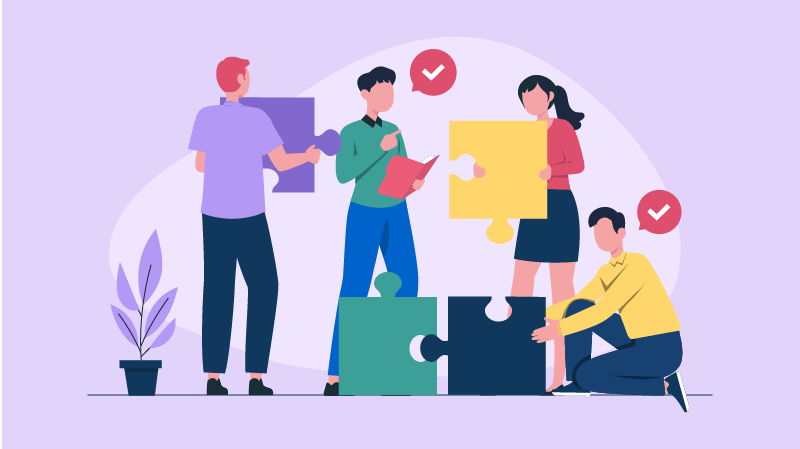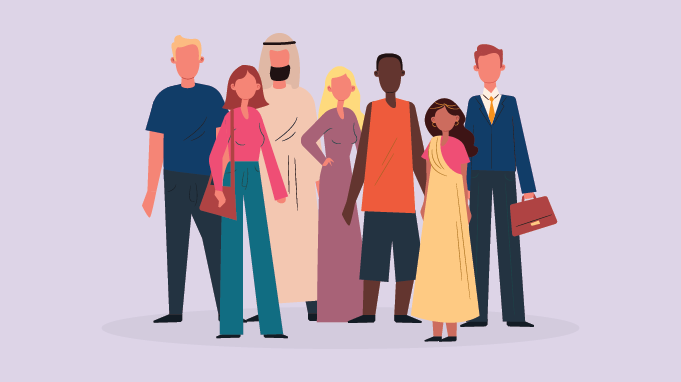Mastering Allyship in the Workplace: From Understanding to Implementation
Everyone is talking about diversity and inclusion these days. It's all over the news, and people are becoming more aware of workplace injustices every day. But, while we live in a time when many of us want to be change agents, we still don't know where to begin. And it is here that the concept of allyship in the workplace gains traction.
This post will discuss what an ally is, the different sorts of allyship, and how to get started with it.
Key Takeaways
- Meaning of allyship in the workplace.
- Types of allies in the workplace
- The challenge of allyship and how to get started with it
- Measuring the impact of allyship initiatives at the office.
- Some famous organizations with allyship programs.
What is allyship in the workplace?
Allyship in the workplace involves supporting and advocating for colleagues from marginalized groups. Allies use their own privilege and influence to help amplify underrepresented voices. They work to improve diversity, equity, inclusion, and belonging. Allies aim to create a more just, neutral, and welcoming environment for all.
Let’s understand better with a quick real-life example.
Cynthia Perry had grand plans for her new career when she started working for a powerful global business leader.
She did, however, leave after a few years.
Perry did everything she could to stay. She talked about her interactions with HR, and she expressed her worries to the leaders. She also made numerous failed attempts to discover coworkers who could assist her in improving her circumstances. At last, Perry decided to leave the organization.
Perry wrote and released a viral resignation letter in which she portrays a toxic work environment in it. As a woman of color, she was subjected to a hostile work environment. She was marked by microaggressions and a lack of workplace equity.
Perry claims that she was "gas-lit, manipulated, bullied, neglected, and mostly unsupported" as a senior manager at the corporation. Many of her superiors never learned how to be an ally in the workplace.
Her experience convinced her that the workplace has chronic difficulties impacting black employees and other marginalized groups. She was also disappointed to realize that the company's leadership was reluctant to resolve these issues. Or even to listen to them.
While Perry's letter received widespread attention, her circumstance is not uncommon. Unfortunately, such a type of experience is too prevalent for marginalized voices, particularly women, BIPOC, and members of the LGBTQ+ community. Many of them have encountered microaggressions, systemic injustices, and other such barriers in the workplace.
As a result, allyship in the workplace has become crucial to cultivating an inclusive atmosphere.
Read our blog on: 8 Ways To Call Out Racial Injustice At Work
Who can be allies in the workplace?
Workplace allies might be of race, age, gender identity, function, or rank. However, they usually hold a position that makes their allyship initiatives more significant.
Cisgender people can be wonderful allies to their transgender coworkers. For the same reasons, men can be great allies to women/non-binary persons. In the same way, white employees can be wonderful allies to people of color. Moreover, senior executives can be great allies to associate-level employees.
The allies with whom they are allying have different identities, and that is the cause for stronger bonding.
Allies don't only influence one person at a time. They act as agents of change to foster an environment of acceptance and support.
Allyship, simply expressed, is a tremendous force for good.
Statistics related to workplace allyship and how it helps
As per different research, allyship is important in the workplace in various ways:
- Allyship boosts retention - Employees are 50% less likely to leave organizations with strong allyship/inclusion.
- Allyship enhances performance - Employees are 56% more likely to improve performance in inclusive cultures.
- Allyship reduces absenteeism - Sick days decrease by 75% when allyship is fostered.
- Allyship improves recruitment - Employees are up to 167% more likely to recommend inclusive organizations.
- Allyship leads to higher employee engagement - Companies with diverse allyship initiatives see 21% higher engagement.
In summary, allyship positively impacts engagement, retention, performance, attendance, and the ability to attract talent. It's a critical component of workplace inclusion.
Types of allies at work
According to Malcom Glenn, there are two types of allyship: effective allyship and performative allyship.
Now, what is the difference between these two forms of allyship in the workplace?
-
Effective allies take real action to drive change for marginalized groups, while performative allies talk about being allies.
-
Effective allies lead initiatives, even when inconvenient. Performative allies support groups only when it benefits themselves.
-
Effective allies follow through on committing to making a difference. Performative allies pretend to help but often cause harm.
In short, effective allies do the actual work as advocates. While Performative allies act like allies but don't support real change. They love to join the bandwagon but in reality, they do not make any difference.
Posting a Blackout Tuesday #BLM picture on Instagram doesn’t do anything, and it doesn’t cost you anything. The real way you show yourself as a true ally is to put some skin in the game. - Malcom Glenn.
Now, if we look at the specific types of allyship in the workplace, Karen Catlin's book Better Allies is an excellent resource that outlines different allyship models. These are the seven types of allies that she mentions:
-
Sponsors: Your job as a sponsor is to encourage your minority-group coworkers by highlighting their skills. The objective is to allow them to contribute to the team significantly and recommend them for learning opportunities.
-
Champion: When addressing issues affecting underrepresented groups, champions should aim to have someone from that group speak instead. However, champions can advocate for the inclusion of minority voices in public settings like conferences, media events, and social media if they notice underrepresentation.
-
Amplifier: As the name suggests, amplifier allies emphasize the voices of marginalized groups. When someone from an underrepresented group proposes an idea, amplifiers repeat it often and focus more on it.
For example, consider this, "In the last meeting, Juan suggested a new approach for improving our product accessibility. His proposal to consult disability advocates would significantly improve our design process. Let's revisit Juan's idea and discuss how we can implement it."
-
Advocate: Advocate allies leverage their power and influence to create opportunities for marginalized groups that have been excluded. They proactively counter omission by selecting qualified colleagues from underrepresented backgrounds for involvement in activities and events.
-
Scholar: Scholars strive to learn as much as possible about the obstacles and biases that colleagues from underrepresented groups face. Scholars always listen and learn rather than add their own thoughts or experiences. They don't expect marginalized people to offer descriptions of best practices or links to studies demonstrating the existence of bias. Scholars conduct their own research to find the pertinent data.
Seek out perspectives from underrepresented groups in your industry by reading, listening to, or engaging with materials created by and about people from those marginalized communities. This can include publications, podcasts, social media, and other platforms where minorities share their voices.
-
Upstander: Upstanders are the first people to take a step forward when they witness discrimination rather than being passive bystanders. They act quickly and decisively when unfair treatment occurs, motivated by justice and empathy. They unambiguously explain why problematic behaviors are offensive and need quick addressing.
-
Confidante: Confidante allies create an environment where people from marginalized groups feel safe and comfortable opening up about their needs, frustrations, fears and challenges. They listen without judgment and validate others' experiences instead of questioning them.
If a gay coworker confided in you about homophobic jokes making rounds, which makes them uncomfortable, as a confidante ally, you would listen supportively, assure them you’re there to talk, and commit to speaking up if inappropriate comments occur.
The challenges of allyship at the workplace
-
As discussed above, performative allyship is a big challenge only about the image, not real change.
-
Assuming one approach works for all marginalized groups is a big concern for people who want to become allies.
-
Burnout from constantly being the one to speak up is a huge concern. Lack of motivation is one of the key factors leading to such burnout. Alongside, allies get discouraged by seeing a slow pace of change.
-
Another concern among allies is expecting marginalized colleagues to teach them versus proactively educating themselves.
-
Robust allyship requires the courage to challenge bias wherever it occurs. Some people act as allies for marginalized colleagues in the workplace but make prejudiced comments or exhibit discriminatory behavior with their family and friends.
How to get started with a great allyship in the workplace?
Begin your allyship by educating yourself about social justice issues. Also, do enough research on the matter to identify the inequity in your environment. Here are some ideas for getting started with allyship in the workplace:
1. Use your privilege
And if we are lucky enough to be in a position of power, if our voice and our actions can mobilize change, don't we have a special obligation? Being an ally can't just be about nodding when someone says something we agree with - important as that is. It must also be about action. It's our job to stand up for those who are not at the table when life-altering decisions are made. Not just those people who look like us. Not just those who need what we need. Not just those who have gained an audience with us. We must improve the human condition - in every way we can, for everyone who needs it. - Kamala Harris.
The National Association of School Psychologists defines privilege as the "unearned advantages that someone receives by identifying or being born into a specific group and that these advantages have not been learned my own hard work but rather their affiliation."
A prevalent misunderstanding is that being a person of privilege entails coming from a wealthy family. When thinking about your privilege at work, it's helpful to start by considering what rights you have that others don't. Understanding how you can use your privilege to help others is the first step toward becoming a better ally.
2. Acknowledge important dates and life milestones
When we listen and celebrate what is both common and different, we become wiser, more inclusive, and better as an organization." — Pat Wadors.
Keep track of important events in someone's life and make a note of them. For example, if they celebrate Diwali, you could wish them on that occasion. You can keep records of dates that celebrate Indigenous Peoples' Day, Transgender Day of Remembrance, National Coming Out Day, Black History Month, Ramadan, Lunar New Year, Juneteenth, Disability Employment Awareness Day, Pride Month, Women's History Month, Holocaust Remembrance Day, International Women's Day, Hispanic Heritage Day, Deaf History Month, and so on.
Birthdays, promotion days, work anniversaries, marriage anniversaries are all good moments for quick recognition. Also, make sure to check in through difficult life events like deaths and illnesses.
3. Communicate
I can't imagine what you've been through, but I want to understand you, okay? I want to help you get through this. If you want to talk, I'm here. If you don't. . . well, I'm still here. Always." ― Kate McLaughlin
Speak with members of historically disadvantaged people to learn how you can help to address the inequities you've noticed. Also, make sure you hear (and magnify) their voices as well.
Microaggressions towards underrepresented groups mostly occur in day-to-day meetings. For example, they are mostly interrupted while speaking, having ideas disregarded quickly, or being completely ignored.
An ally can set a good example by being active listeners rather than speakers. Allowing attendees to speak without interruption is one strategy allies may use to foster a more inclusive workplace.
The goal of privileged groups in allyship should be to use the privilege and authority to uplift others. It is by taking proper action and stepping up regularly. Finally, seek feedback on your allyship effort and fine-tune your strategy accordingly.
4. Acknowledge and recognize their expertise
Allyship is not self-defined. Our work and our efforts must be recognized by the people we seek to ally ourselves with.
Underrepresented people are frequently questioned about their expertise and skills. Make a point of acknowledging their knowledge and abilities by soliciting their feedback and ideas.
Recognizing someone's accomplishments is one of the best methods to acknowledge what they've accomplished. We could do this in subtle ways, such as sending a thank you note for their important contributions to a project. You can also go bigger, such as by making public statements or giving rewards.
Know more here: The Ultimate Guide to Rewards and Recognition
5. Provide constructive feedbackGive feedback as an ally, not as a critic.
White men in managerial roles are unsure how black women and people of color will receive their comments. As a result, the latter receives less high-quality feedback that can assist them in making necessary adjustments. As a result, they fail to grow as great leaders.
When they get formal feedback, it's usually about their communication styles. They do generally give any meaningful developmental feedback on their knowledge and skills.
As an ally, you should devise a strategy to help URGs to enhance their talents and advance in their careers. Provide constructive feedback on meetings, proposals, and leadership initiatives as well. It boosts their self-esteem, teaches them what works, and motivates them to try new things.
Measuring the impact of allyship initiatives at the office
Establishing metrics is essential for companies to quantify the outcomes of allyship and gauge progress in achieving inclusion goals. Some key performance indicators that can provide insight into the impact of allyship programs include tracking metrics such as:
- Number of allyship events and activities held.
- Participation rates in employee resource groups for underrepresented groups.
- Increased representation of marginalized groups in leadership roles.
- Employee feedback on perceptions of inclusion and belonging.
- Reduced turnover among marginalized demographic groups.
- Number of complaints related to discrimination and bias.
- Rates of promotion and compensation equity between groups.
- Percentage of employees who complete allyship training.
Consider the following tips for measuring allyship impact:
- Define why you want to measure allyship and how you'll use the data.
- Involve your team in selecting metrics and data collection methods.
- Choose key indicators tied to allyship and inclusion goals.
- Collect quantitative and qualitative data from surveys, reviews, etc.
- Communicate results and transform insights into actions.
- Refine the measurement process based on feedback.
- Keep it focused, adaptable, and linked to driving change.
Real examples of allyship in the Workplace
Many companies now mandate allyship training and seminars centered on being an ally to underrepresented people.
Johnson and Johnson's Initiative
With their "broad-based educational initiative to increase awareness and dialogue around allyship, in connection with microaggressions, within and for our LGBTQIA+ community.," Johnson & Johnson is supporting LGBTQ allyship.
J&J's allyship program is initiated by:
Renée Evans — Learning Management Systems Team Lead
Glenn Wrightington — Sr. NPI Supply Chain Planning Analyst
Tiffany Boyer — Sales & Distributor Services Procurement Category Associate
Renée aims to raise awareness about workplace microaggressions and allyship. On her J&J career page, she says:
Whether it's through your manager, HR, Open&Out—our Employee Resource Group for the LGBTQIA+ community—or the Office of Diversity, Equity and Inclusion, we have channels for individuals to go through so that they can continue to learn. Everyone across our entire organization needs to know that this is an inclusive, safe place. And at the end of the day, we're all still learning.
Read our blog on: 25 Virtual Pride Month Ideas To Celebrate LGBTQIA+ Rights
Glenn also adds his opinion, saying:
My passion for this training stems from conversations with colleagues and family about my involvement with Open&Out, where a reoccurring comment I heard was, 'I wouldn't know what to do.' I realized that there could be many other allies hiding behind that same comment and afraid to step out. Once we launched this initiative, we also realized we needed to expand globally. It comes with translations and updates to reflect regional laws and safety. We want to ensure that everyone can bring their best self to the workplace.
Microsoft's Effective Allyship Program
Amid the global chaos of 2020 — including a pandemic requiring remote work and making relationships more challenging, acts of hate toward those with Asian heritage stemming from false rhetoric about the virus, widespread protests against racial injustice following violence against Black and African American people, and increased political tensions.
The program consists of different components in diverse mediums that cater to various learning styles. The purpose of their allyship in the workplace program, according to Chief Diversity Officer Lindsay-Rae McIntyre, is to:
Give Microsoft's 160,000 employees worldwide the language they need to discuss different viewpoints and difficult things in a way that offers empathy and inclusion to all.
EndNote
Building a culture of allyship in the workplace is integral to business success.
We all want to do great things for others but are unsure how. It entails asking what others want rather than assuming it. It's sometimes just a matter of asking your team member: "Can I help you with something?"
Have you come across any such outstanding examples of allyship in the workplace? Or do you think you and your coworkers have some other initiatives? Please share with us.


















